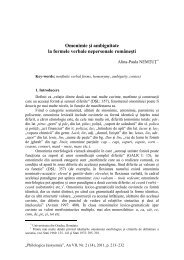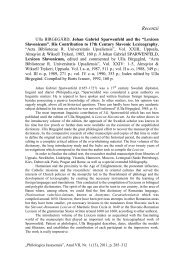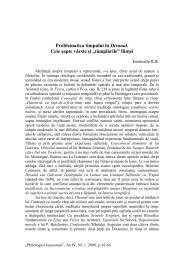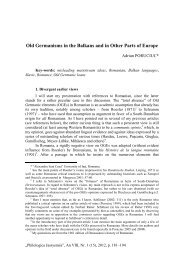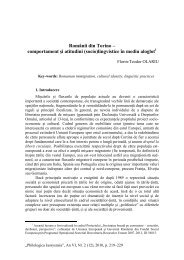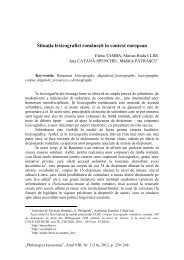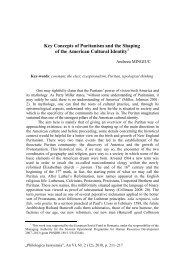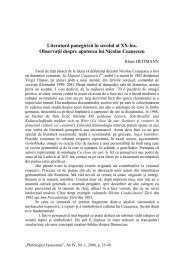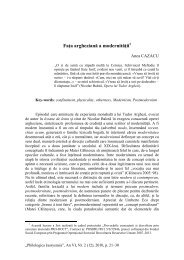Articol despre Stierle - Philologica Jassyensia
Articol despre Stierle - Philologica Jassyensia
Articol despre Stierle - Philologica Jassyensia
You also want an ePaper? Increase the reach of your titles
YUMPU automatically turns print PDFs into web optimized ePapers that Google loves.
Philologia Perennis<br />
A Romanian Literary Topic – The Baragan Plain<br />
Mihaela ALBU<br />
“The world axle is<br />
passing through Baragan”<br />
(Fanus Neagu)<br />
Keywords: Baragan- the Romanian prairie, the Romanian Arcadia, territory<br />
of the thistles, country of bustards, a legendary land<br />
The Romanian Steppe – the Baragan Plain<br />
If you ask the Romanians about the geographic specificity of their country,<br />
the answer would refer commonly to the diversity of the relief and especially to<br />
what the poet-philosopher Lucian Blaga called “the undulatory space”.<br />
Even though we usually define ourselves according to what Blaga called “the<br />
mioritic space”, “the undulatory space”, the matrix-space with the alternation hillvalley,<br />
we have to take into consideration the other geographic areas of the<br />
Romanian territory. Besides the Carpathians and the hills, a vast plain lays in the<br />
south, the Danube Plain, which includes the Baragan. This is the Romanian prairie<br />
that reminds us of the Russian steppe, of the Hungarian pusta, but also of the<br />
unlimited sea or ocean: the same immensity, and the same illusion of no boundaries.<br />
This vastness of plain, reminiscent of the immensity of the sea or of the ocean,<br />
was described in different manners and from different point of views by the Romanian<br />
writers such as Alexandru Odobescu (1834-1895), Panait Istrati (1884–1935), Mircea<br />
Eliade (1907–1986), George Calinescu (1899–1965), Marin Preda (1922-–980), Stefan<br />
Banulescu (1926–1998), Fanus Neagu (1932–), Constantin Toiu (1923–), etc.<br />
In Romanian, the word comes from Turkish and means “gale”, “snowstorm”.<br />
The Romanian Baragan is a unique territory, a weird and wonderful area, a combination<br />
between “desert and no desert”, as one of the most important Romanian historian<br />
Nicolae Iorga (1871–1940) described it.<br />
The classic example of the Baragan picture (being at the same time a model of<br />
a literary description) could be found in one of the most singular and interesting<br />
books in Romanian literature, the essay called Pseudokynegeticos, by Odobescu. An<br />
inedited literary formula, taking as a pretext “the hunting”, this essay is a kind of<br />
literary journey in the history of arts, of music, of literature, in folklore and traditions,<br />
it is “a mosaic” (in George Calinescu’s terms), but it is above all a journey in time and<br />
space. “I started scouring the ages and spaces, looking for sounds and hunter’s<br />
emotions with my eyes, my ears and my heart”, wrote Odobescu in the Preface.<br />
„<strong>Philologica</strong> <strong>Jassyensia</strong>”, An IV, Nr. 2, 2008, p. 9–15
Mihaela ALBU<br />
1.a. The Baragan – a Romanian Arcadia<br />
“Et in Arcadia ego!” – exclaims Odobescu in the beginning of his description<br />
of the Baragan plain, the space where the hunters can find their Paradise. The whole<br />
description is framed between that exclamation and a Gogolian expletive – “Damn<br />
you, plains, you are so beautiful!” (Odobescu 1990: 15). Recognizing that his<br />
description is almost a kind of translation of a fragment from Gogol’s Taras Bulba,<br />
the writer implicitly suggests the similarities between the Romanian Baragan and the<br />
Russian steppe.<br />
Odobescu, Calinescu and Fanus Neagu described the Baragan as an Arcadia,<br />
a rich territory in grain and also an attractive space. “Out of what Baragan really is,<br />
my flesh withholds […] the everlasting fragrance of the wheat”, confesses Fanus<br />
Neagu in the Postface of his book Under the Moonshine (Neagu 1979: 355). The<br />
wheat is the real richness of the Baragan, the wheat made this land famous; the<br />
wheat is “the human law, just the horse’s is the grass”, adds Fanus Neagu. “The<br />
world’s axle is passing through Baragan, because the beginning and the duration of<br />
all the worlds is getting through each and every wheat-ear stalk”, the writer<br />
continues metaphorically his confession.<br />
On the other hand, in his book of short stories – An Imaginary Kingdom –<br />
Stefan Banulescu describes “the yellow land with the abundance of corn; when the<br />
sun sets, daylight goes on because of the corn” (Banulescu 1997: 35). Both wheat and<br />
corn give the impression of an “immensity of the field’s solar tint”, and an isolated<br />
village seems to have “sun in the right, sun in the left”.<br />
The seasons influence the man’s life in the Baragan. His life is coordinated by<br />
the time of year. In summer, the plain gives to him the crop, the real purpose the<br />
countryman works the whole year. “In July, wheat is active in every action of life,<br />
including the memorial of the dead”. This is the Baragan, the plain whose “lung’s<br />
breath wheat” (Neagu 1979: 357).<br />
1.b. My village props its bone on the false acacia trees (Fanus Neagu)<br />
The Baragan, this “miraculous” plain, as many Romanian writers felt or<br />
wrote, this “edge of infinity”, this rich and poor territory, a strange mélange of<br />
wilderness and richness, where both hunter and peasant find their reason to live, can<br />
be branded through some specific plants. Besides the thistles, in this vast territory,<br />
where – in winter – the snow is abundant, and in summer the sun is shining so hard,<br />
the only tree that could resist to the aggressive weather is a species of the acacia, the<br />
false acacia. In the village of the Morometes “the place was full of acacias and of tall<br />
grass”. “A giant acacia … very leafy and tall” becomes an important part in the plot<br />
of the novel. Moromete, the peasant who tries to avoid paying taxes because he (as<br />
the majority of the others) has no money, cut the acacia and sold it: “as they had<br />
nothing else to sell, the acacia had to be cut down” (Preda 1957: 111), the narrator<br />
comments. It was “a some tough tree”, Moromete himself will notice later, sad and<br />
proud at the same time.<br />
The acacia had to be standing there, with its majestic height and its leafy<br />
crown like a sentinel above all that part of the village; now everything seemed to have<br />
10
A Romanian Literary Topic – The Baragan Plain<br />
shrunk in size. The garden, the horses, Moromete himself, looked as if they had been<br />
dwarfed. The open sky and the fields now seemed to dominate the neighborhood<br />
(Preda 1957: 111).<br />
Fanus Neagu remembers also many times (in Under the Moonshine) about the<br />
dead acacias and describes them as some phantoms.<br />
1. c. The country of the flock of bustards (Odobescu)<br />
The Baragan is at the same time “the country of the flock of bustards”: „In<br />
July the bustards […], like the Danube flamingos, walk their chicks through the<br />
wheat field…”, wrote Fanus Neagu (Neagu 1979: 358). It is a very strange bird,<br />
very difficult to see or to catch – as we learn from other Romanian writer, born in<br />
the Danube Plain, Stefan Banulescu. In his novel entitled Dropia (The Bustard), this<br />
bird is not only a metaphor, but also a reality of this part of the country. This rare<br />
bird is “hard to catch sight of, not only to be grasped. The bustard can’t be caught<br />
either in summer or in autumn, it is difficult to get a glimpse of it, it stands in the<br />
sun at the edge of the stubble. And one can’t look at the sun. It is only on the glazed<br />
frost in winter that one can touch it, when its wings get heavy hindering into fly and<br />
making its walk looks like a hen’s. Even then it’s a hard job”, explains allusively<br />
Victoria to a “stranger”, Miron, who was looking for his former love from his youth.<br />
“Rarely can anyone catch the right moment. Many times, when it is glazed frost,<br />
there is no buster in sight, and when there is one, there is no glazed frost”, she<br />
continued in the same metaphoric and allusive style (Banulescu 1997: 43).<br />
2. The Baragan - the country of the thistles<br />
Paradoxically, the Baragan, “the country of grain”, is also a wild field, “the<br />
country of the violet thistles” that inspired the Romanian-French writer Panait<br />
Istrati 1 in his well-known novel The Thistles of the Baragan. In this book, Istrati<br />
chooses the first sentence of the novel, the incipit of the story a time projection and<br />
space delimitation: “When September dawns, for one month, the vast, wild plains of<br />
Danubian Wallachia settle down to their millenary existence” (Istrati 1930: 9).<br />
Therefore, the fall and “the millenary existence” suggest the repetition that means an<br />
endless time and a boundary space (the vast plain). The second sentences refer again<br />
at “the endless steppe” and gradually the author introduces the place – “Muntenia”<br />
(Wallachia), “the woeful Ialomitza” river and “the grumbling Danube”, the<br />
adjectives being a special projection of the feelings of the inhabitants. The type of<br />
relation between man and the Baragan is stressed also from the very beginning: “It<br />
loves him not.” (…) Like a desert, “the Baragan is solitude itself” (Istrati 1930: 11).<br />
The narrator transfers the human characteristics to the territory: “At first the Baragan<br />
does so passively, like a man who lies down, buries his face in the ground and<br />
refuses either to rise or die. The Baragan is a giant” (Istrati 1930: 10).<br />
1 A. Gide wrote in his Journal, Univers Publishing House, 1970: 551): „It was with great pleasure<br />
that I read Kira Kiralina, the particularly lively story of Panait Istrati’s, a narration of a genuine fragrance<br />
redolent of some stories from Thousand and one nights or maybe of any other picaresque novel”.<br />
11
Mihaela ALBU<br />
“An important narrative presence are the Danubian and Deltanian emptiness<br />
or the Baragan prairie”, writes the critic Aureliu Goci in his Preface at the Romanian<br />
version of The Thistles of Baragan (Istrati 1992: 14). In this novel it takes place a<br />
continuous fight between the plain and the man, and the winner is, almost always,<br />
the Baragan:<br />
Stretched out, since all eternity, over all the sun-scorched lands between […]<br />
Ialomitza and the Danube, the Baragan wages a sly war, throughout spring and<br />
summer, against the hard-working peasant [...] For the Baragan is solitude itself.<br />
Never a tree on its back; and between one well and the next, a man has time aplenty to<br />
die of thirst. Nor is it any business of the Baragan’s to shield you from hunger, either.<br />
When the fall is coming and the storks are going to the warmer countries, “the<br />
Steppes of the Baragan assume complete mastery” (Istrati 1992: 10, 11).<br />
In Baragan, the man is under mastership of the geography, and he has to<br />
accept this and learn how to survive according to the rules of this special territory,<br />
“that land that knows no master” (Istrati 1992: 29), where you cannot find “a tree on<br />
its back; and between one well and the next, a man has time aplenty to die of thirst”<br />
(Istrati 1992: 11). Undoubtedly, from time to time, the writer cannot forget that there<br />
are also parts of the Baragan where the land is seemed to be “an Arcadia” and<br />
describes the both sides of the Ialomitza river where “the land is fertile, the farms<br />
numerous. There the Baragan gnaws with broken teeth” (Istrati 1992: 58).<br />
3. The Baragan – a legendary land<br />
Moreover, Mircea Eliade, the well-known scholar and writer, saw the Baragan<br />
Plain as a legendary territory, where space is stronger than the time.<br />
Therefore, almost everywhere, in every Romanian literary work, the reader<br />
can detect – in parallel or in interference – both the real geographical elements and<br />
the utopian perspective. The different scale makes the difference. In Banulescu’s The<br />
Millionaire’s Book (Cartea Milionarului), according to another Romanian critic, Ion<br />
Negoitescu, the plain is “the Utopia in a large sense, like an imaginary topos, in a<br />
perfect opposition with the real, even though it borrows different elements from it”<br />
(Negoitescu 2004: 36). One of Banulescu’s books was named exactly An Imaginary<br />
Kingdom and many stories seemed to come from the fairy tale (“A Man with no<br />
Night”, “The Gold Knife”, “The Sun, a Golden Raven”, “The Man and the Death”).<br />
For Fanus Neagu, the Baragan is “the gateway into the timeless joy” (Neagu<br />
1979: 355). The old stories, the legends, the people from the plain themselves were<br />
constant subjects and background for his books. All these gave him also that special<br />
gift of dreaming, allowing him to make a bridge between past and present, between<br />
myth and reality, and (as himself considers) made him a writer (“The Baragan plain,<br />
the bodies of water, my parents’ and my grandparents’ stories made me born within<br />
myself the to be writer” (Neagu 1979: 356). In other sense, the Baragan is a “fata<br />
morgana”, the miracle created by the vastness and the immensity of the desert.<br />
For the novelist George Calinescu, for example, following his characters –<br />
Felix and Otilia – in their way as the guests of the rich farmer, Pascalopol, to his<br />
farm in Baragan, the plain seems a very strange place with no limits (like a desert)<br />
being at the same time beyond the time. With a lack of proportions or with a “mad”<br />
12
A Romanian Literary Topic – The Baragan Plain<br />
proportion, the Baragan looks like a wasteland where the civilization has no<br />
meaning and seems to be unhistorical “scythic deserts”:<br />
It was only one hour since Felix was getting off the train, but he felt lost for<br />
hundreds of years in the places where any trace of civilization was destroyed long<br />
time ago by the sun and the vegetation (Calinescu 2000: 78–79).<br />
So, in Baragan, the absolute “master” are the sun and the vegetation. The time<br />
and even the space lost their real dimension: “Felix couldn’t realize if they were far<br />
at two hundred meters or a few kilometers” (Calinescu 2000: 77). Thus, from a<br />
literary description of the real geographical place to the identification of the plain<br />
with the Utopian region, this is the “road” between the descriptive fragments (in the<br />
classical manner) and the mythical and symbolical stories or novels.<br />
4. The Baragan – the fickle ocean<br />
In Odobescu’s essay regarding the hunting, the potential hunters scour “the<br />
desert of the Baragan”, and in front of them is always “the boundless space” with<br />
“the waves of grass” like a “fickle ocean”. In The Morometes also – “the light<br />
morning breeze… transforms the wheat into sea-waves.” This kind of comparison,<br />
with many words from the same lexical field Calinescu uses, too, in a memorable<br />
description of the Baragan in his novel Otilia’s Enigma. Some isolated trees in the<br />
empty field seemed “dead block stems on the waves of the sea”. The warm wind was<br />
“massive like a marine wave”. The travelers – Felix and Otilia – “were floating on a<br />
yellow-green sea, where the too much high waves hinder the eyes to put the horizon<br />
line in its place” (Calinescu 2000: 77–78).<br />
5. The Baragan – and its connotations<br />
A proper name (a certain place), but also a qualification – the word “Baragan”<br />
has a special connotation in the Romanian language. Panait Istrati, an “expert” in the<br />
Romanian plain, explains one. According to him, “everywhere in Romania, when a<br />
man is taking too many liberties in public”, he is apostrophized: “where do you think<br />
you are: on the Baragan?” Thus, the lack of boundaries is transferred to the people,<br />
to their behavior and way of understanding the world. In the same direction, but with a<br />
plus of connotation is another commonly used phrase: “It’s the end of the world,<br />
children. They are doing as they please with us. It’s like the Baragan.” Let’s do not<br />
forget that The Thistles of the Baragan is dedicated to “the Romanian people; to its<br />
eleven thousand sons murdered by the Romanian government” in the revolt from 1907!<br />
6. The Man and the Plain<br />
If Lucian Blaga invented the concept of “the mioritic space” as a<br />
philosophical manner to explain the Romanian soul and spirit through the Romanian<br />
landscape (“the undulating and infinite landscape” of hills and valleys), there are<br />
also other writers who described the behavior and the spirit of the peasant from the<br />
south of Romania through the mark of infinity and the monotonous relief of the<br />
plain. Marin Preda, considered one of the best Romanian contemporary writer sees<br />
the peasant from the Danube Plain as a thinker, a contemplative, in a “Socratic”<br />
13
Mihaela ALBU<br />
manner, and less as a practitioner. “Down in the plain of the Danube”, at least “a<br />
few years before the Second World War”, the time when the Moromete family is<br />
seen as a model of a Romanian peasant family, “time seems to have been very good<br />
for the peasantry; life went on there without too much trouble” (Preda 1957: 7). It<br />
was a life of a family in the Baragan, and Moromete, the father and the prototype of<br />
the peasant from the plain, who has his own philosophy over life, is seen from the<br />
very beginning of the story “seated on the rail of the plank-bridge” and “looking<br />
across the bridge. He just sat there, at a loose end, looking at nothing in particular.”<br />
Even “the smoke of the cigarette in his hand was rising straight up, without haste or<br />
purpose” (Preda 1957: 8).<br />
No “haste or purpose” appeared to characterize the whole life in Baragan. The<br />
people of the large spaces seemed to borrow from the plain the special feeling of<br />
vastness and eternity. “If you are armed against these two twin ailments of the flesh”<br />
(thirsty and hunger), wrote Panait Istrati, “and if you wish to walk alone with your<br />
God, go out to Baragan; it is precisely the place the Creator allotted to Wallachia for<br />
the Romanian to dream away at this leisure” (Istrati 1930: 11). The former<br />
inhabitant of the plain stressed out the special feature of the “Baragan-man”, his<br />
tendency to dream and to contemplate the world. “There are places in the world<br />
destined for contemplation” (Istrati 1930: 11). The man who dwells on the Baragan<br />
has “a rather grave character. […] Dreams, meditation, aspiration and a hollow belly<br />
are what give man gravity” (Istrati 1930: 12). The people “prefer to listen<br />
differentially. That is because their lives are hard and because they live in the hope<br />
that someone may appear to teach them what to do so as to wrest the best possible<br />
advantages from their steppes” (Istrati 1930: 12).<br />
Conclusion<br />
For many Romanian writers the Baragan plain has always been geography<br />
beyond real, or rather a utopia and a myth.<br />
The Baragan has a millenary existence, and the people who live there know<br />
that it is sometimes “lazy and disobedient” and they have the feeling that “life takes<br />
its form from sleepiness and gets its continuity from mirage” (Istrati 1930: 133).<br />
This “mirage” is – in a metaphorical way – the endless dream of “walking the line”,<br />
of crossing the “borders” toward the civilization, toward the city where its<br />
inhabitants “have some bread to eat”.<br />
In Lucian Blaga’s opinion,<br />
Romania’s lowlands are imbued with longing for the high mountains<br />
meadows. The people from the fields do not have such meadows, so their soul and<br />
mind made up for its atmosphere – through their songs (Blaga 1999: 56).<br />
Can we find “the longing for the high mountains meadows” in the novels<br />
where the characters live in the Romanian plain? I cannot find it, at least in the<br />
authors cited above. Can we depict the same kind of “Mioritic’s sense of destiny” in<br />
the folklore of the population who live in the plain? It is a topic that can be studied<br />
with another occasion. Now, let’s go back to the Romanian writers who saw man<br />
living his destiny as an inhabitant of the boundless space of the field. This field, like<br />
the ocean, gives him a different perspective. The writers described this territory and<br />
14
A Romanian Literary Topic – The Baragan Plain<br />
tried to understand both the life of the Baragan regions inhabitants and their<br />
particular viewpoint about life.<br />
Bibliography<br />
Blaga 1944: Lucian Blaga, Trilogia culturii, Bucureşti, Fundaţia Regală pentru literatură şi artă.<br />
Blaga 1999: Lucian Blaga, Mioritic Space (a fragment), in Ten Steps to Romania, Bucureşti,<br />
Fundaţia Culturală Română.<br />
Călinescu 1982: George Călinescu, Istoria literaturii române de la origini până în prezent,<br />
ed. a II-a, Bucureşti, Minerva.<br />
Gide 1970: Andre Gide, Jurnal, Bucureşti, Univers.<br />
Negoitescu 2004: Ion Negoiţescu, Scriitori români contemporani, Cluj-Napoca, Dacia.<br />
Sources<br />
Banulescu 1997: Ştefan Bănulescu, Un regat imaginar, Bucureşti, ALLFA.<br />
Calinescu 2000: George Călinescu, Enigma Otiliei, Bucureşti, Cartey.<br />
Istrati 1930: Panait Istrati, The Thistles of the Baragan, NY, The Vanguard Press.<br />
Istrati 1992: Panait Istrati, Ciulinii Baraganului, Bucharest, Mondero Publishing House.<br />
Neagu 1979: Fănuş Neagu, In văpaia lunii, Bucureşti, Eminescu.<br />
Odobescu 1990: Alexandru Odobescu, Pseudokinegetikos, Bucureşti, Albatros.<br />
Preda 1957: Marin Preda, The Morometes, translated by N. Misu, Bucharest, Foreign<br />
Language Publishing House.<br />
Un « topos » littéraire roumain – Baragan<br />
L’espace-matrice roumain avec ses alternances colline – vallée, défini par Lucian<br />
Blaga comme « espace mioritique », n’est pas le seul ayant attiré l’imagination créative des<br />
écrivains roumains. Au delà de nos montagnes et de nos collines une vaste vallée s’étend au<br />
sud. Il s’agit de la Plaine du Danube qui inclut aussi la Plaine de Baragan, une plaine que<br />
nous pouvons associer à la préerie mais nous fait aussi penser à la steppe russe ou à la<br />
Puszta hongroise de même qu’à l’infini de la mer ou de l’océan – la même immensité et la<br />
même illusion impossible à limiter.<br />
La vastité de Baragan a été décrite en différentes manières et de plusieurs points de<br />
vue par des écrivains comme Alexandru Odobescu (1834–1895), Panait Istrati (1884–1935),<br />
Mircea Eliade (1907–1986), George Calinescu (1899–1965), Marin Preda (1922–1980),<br />
Stefan Banulescu (1926–1998), Fanus Neagu (1932–) etc.<br />
Dans notre ouvrage nous suivons dans quelques chapitres (dont le titre reprend des<br />
phrases significatives des romans en discussion) les différentes facettes de la présentation de<br />
Baragan faites par les écrivains mentionnés.<br />
C’est comme ça que nous découvrons la plaine de Baragan comme une « Arcadie<br />
roumaine », un espace qui « soutient son corps sur des acacias », c’est « le pays des volées<br />
d'outardes », mais aussi le territoire des « chardons »; l’espace étendu vers l’horizon rappelle<br />
l’infini de l’océan, c'est un endroit riche en légendes dans lesquelles l'homme devient frère de la<br />
plaine ayant le sentiment de vivre dans un lieu qui transfère les sens, au delà du réel, dans le mythe.<br />
15<br />
University of Craiova<br />
Romania



